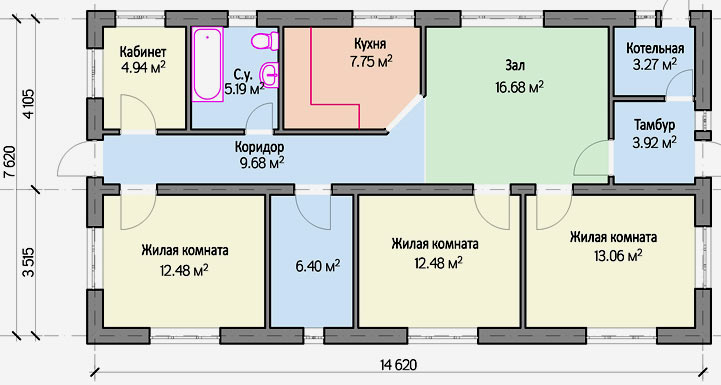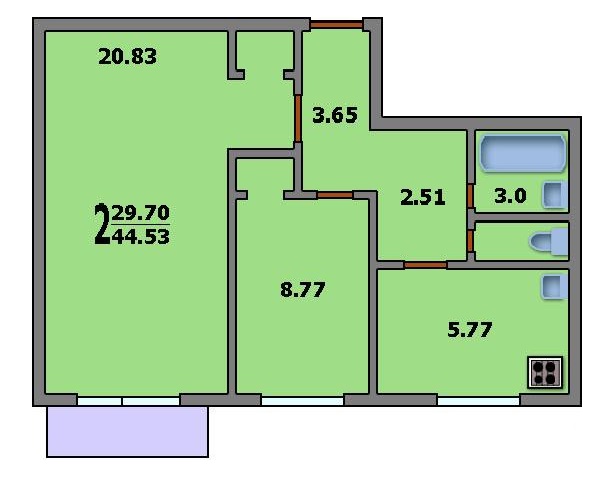Special attention accountants require dividends. Accounting This category of payments has its own characteristics. In addition, not all specialists faced dividends in practice: in some companies, in principle, they cannot be by force of law, in others - management prefers to let them out for other needs of their business. Therefore, let’s put in the know.
Main rules
Business participants have the right to net income from it among themselves. Then the question arises of how to calculate the profit that can be so disposed of. In this case, the task of the accountant is quite simple. There are two ways:
notice, that dividend accounting implies that it is possible to divide both the net income of the past year and past periods.
Payment Decision
Accrue
How to hold dividends in accounting, officials of the Ministry of Finance prompted a little in the explanations of May 19, 2015 No. 07-01-06 / 28541. Based on their opinion, we will show in the table accounting entries for the calculation and payment of dividends.
Keep in mind: All entries are made by the date of signing the minutes of the general meeting of the LLC (the sole decision of the founder of the company).
We pay
| The essence of manipulating dividends | Dt | Ct |
| Hold personal income tax | There are two options:
| 68 "Calculations on taxes and fees” |
| We bring personal income tax to the treasury | 68 "Calculations on taxes and fees” | 51 "Current accounts" |
| We pay to the participant | The same two options: 1) 75-2 "Calculations for the payment of income"; | Two options: 1) 51 "Settlement accounts"; |
We reflect in the balance
Basic rule dividend accounting lies in the fact that the amounts allocated to the participants are shown in the period when they are accrued.
The amounts accrued from the remaining profit of previous periods are entered on line 1370. That is, you need to proportionally subtract the amount of dividends from it.
If we talk about mid-year dividends, etc., they are shown in the third section - “Capital and reserves”. Separately from each other and in parentheses.
Some legal entities that apply a simplified taxation system are often owners of other companies, which in turn brings them additional income. To additional financial resources can be attributed to the distributed part of dividends.
It is worth noting that enterprises operating under the simplified taxation system are exempt from payment, as well as on property. In addition, under the corresponding system, VAT is not paid, which should be in mandatory repaid upon import of goods into the country.
Dear readers! The article talks about typical ways to solve legal issues, but each case is individual. If you want to know how solve your problem - contact the consultant:
APPLICATIONS AND CALLS ARE ACCEPTED 24 HOURS AND WITHOUT DAYS OFF.
It is fast and IS FREE!
In accordance with article 43 of the current Tax Code Any dividends received by the head from another organization as part of the distribution received after tax can be recognized as dividends of the Russian Federation.
To understand what dividends are in accounting, you need to refer to the provisions of federal law, to special tax regimes, to situations with postings, with the established procedure for processing, accrual and issuance, as well as with the procedural moments of calculation through a specialized program.
Statutory regulations
The corresponding concept can be interpreted in different ways in the provisions of the Tax and Civil Code. In the Civil Code of the Russian Federation, the concept of directly contacting exclusively with joint-stock companies. In accordance with the regulatory articles of the Code, it is established that we are talking about the payment of dividends on placed securities, as well as the redistribution of profit between participants in the company.
With regard to the provisions of the Tax Code, in accordance with Article 43, dividends can be recognized as any income that a shareholder received from a certain organization as part of the distribution of profit on shares owned by the person in the authorized capital of the enterprise. In accordance with this, dividends for taxation include income from securities and profits from equity participation.
In cases where the domestic organization is the main source of dividends, it is automatically recognized as tax agent. Based on the provisions of Article 24 of the Tax Code, tax agents may be persons who have obligations to calculate, withhold, and transfer to a corresponding budget level certain taxes.
Mandatory Elements
Special tax regimes
If the source of income is a specific enterprise that applies special tax regimes, for example, UTII, STS or USCH, then it also imposes obligations inherent in tax agents. This provision is clearly regulated by Article 275 of the current Tax Code.
It is worth noting that for organizations that have been transferred to the UTII system, exemption from payment of the corresponding tax levy in favor of the budget. Those companies that use the simplified tax system or pay UTII can not be payers of corporate income tax, and, therefore, should not prepare a special tax return.
Immediately after such companies begin to fulfill the duties of tax agents, the situation changes radically. The obligation to provide to the territorial office automatically arises. tax service special documentation. The declaration form is approved in accordance with the order of the Ministry of Finance of 11.11.2003.
As part of the declaration, each specific tax agent must necessarily prepare title page, subsection 1.3 on sheet 1, as well as sheet No. 3 for calculating the tax income tax in the form of dividends.
Wiring situation
Securities income is a dividend. In this case, they can be understood as a certain percentage of the income of a particular organization for a certain time period. To deduct dividends under accounting special wiring is used, which is an entry in the documentation or in a computer database about the current state of an object.
Postings in each case include two key elements - debit and credit accounts. Within this framework, an indication of the characteristics of a particular operation also occurs. This may be a quantitative or qualitative characteristic. In cases where dividends act as an accounting object, then a detailed identifier of the analytical plan is used for their accounting.
There is always a designation of income and existing counterparties. The procedure for accounting for deductions under dividends has a fairly large number of features and nuances. It is recommended that you familiarize yourself with them in advance to minimize the risks associated with making certain errors.
If during the inspection the employees of the territorial branch of the tax service find certain blots or shortcomings, this may lead to the initiation of a desk audit. It is worth noting the fact that authorized auditors in many cases find errors in accounting even bona fide tax agents.
Order of registration
Certain rules regarding the form of the minutes of the meeting of authorized representatives of the organization are not established by applicable law. The relevant documentation is drawn up exclusively in free form, but subject to the inclusion of all established details, for example, the date of the preparation of the document and its serial number.
If the company has only one founder, then instead of the minutes of the meeting, a special decision is made by the participant upon the payment of dividends. Regulatory requirements are not presented to the form of such a document, except for the preservation of details. Within this framework, it will be sufficient to reflect the level of net profit of the organization, which will be paid in favor of a particular founder or shareholder.
Dividends in accounting for each participant are calculated based on. Its form is developed internally by the organization, and the document itself is mandatory fixed in accounting policies. The issue of dividends from the cash register is made out through the expense cash warrant. In the case of the transfer of funds from the current account, a special one is applied.
Dividends may be accrued based on the results of the production and marketing activities of the company for a certain period of time, by which it can be understood:
- 3 months;
- 6 months;
- 9 months;
- 12 months.
Charges and extradition
The accrual of dividends, as well as the established procedural procedure, is determined in accordance with the explanations of the Ministry of Finance of 05.19.2015. In accordance with the information presented in the document, postings are developed as part of accounting for the payment of funds under dividends.
All relevant information on the accrual is presented in the table version below:
Within this framework, it is especially important to take into account the fact that all relevant records are made according to the date of drawing up the minutes of the general meeting of the enterprise or the decision of the founder of the organization.
When paying dividends, the following table will help you find out all about the relevant transactions:
Accounting dividends and payout sources
In 2019, in accordance with Article 4 of the Federal Law No. 129, which governs the accounting procedure, it is established that those organizations that switched to the simplified tax system may be exempted from the obligation to maintain accounting. However, it is worth noting the fact that the relevant companies must keep records of fixed assets and assets of an intangible nature.
The source of payments is the profit of the company after taxation. The net profit of the organization is determined in accordance with the information in the financial statements. At the same time, companies that use the simplified tax system and pay a certain amount of income in the form of dividends should determine net profit on the basis of an accounting plan for financial and economic activities.
The payment of dividends becomes impossible in cases where at the time of the transaction a specific organization is in a state. Or on the day of payment, the value of the company's assets is less than or.
Calculation through 1C
The calculation of dividends in the vast majority of cases is carried out using the 1C program. Reflection of accrued payments in favor of physical or legal entities, as well as the calculation of tax on profit and personal income tax in this program are registered using the document Operation, which is available at the appropriate link in the accounting and taxes section.
It is worth noting the fact that at the time of the formation of the decision on the payment of dividends, all required entries are entered into the program manually in relation to each participant or shareholder. Amounts of accrued payments are not reflected within tax accounting. This is due to the fact that account number 84 does not support tax accounting.
On the date of payment of the corresponding dividends, tax agents in each case have an obligation to withhold tax on profit from dividends of the company, as well as personal income tax from dividends of a certain individual. Corresponding postings are developed based on the document Operations in the order of manual entry.
Payment of personal income tax from dividends must be made no later than the day of their transfer or receipt of funds in a certain financial organization for payment. This provision is clearly regulated by article 226.1 of the current Tax Code of the Russian Federation. Dividend income tax is paid no later than the day following the next day that the relevant payments are paid.
It is important to remember that the amount of accrued tax on dividends should not be reflected in tax accounting.
Frequently asked Questions
In the framework of accounting for dividends, certain questions may arise with the participants in the operation.
The most popular of them are presented below:
| The organization paid dividends during a certain reporting period using quarterly payments. At the end of the set period of time, the result financial activities enterprises became a loss. Could this somehow affect the amount of dividends, because their payment is carried out by subtracting from net profit, which the organization as of a certain moment does not have? |
|
| Is it necessary to withhold personal income tax from a certain amount of dividends paid in favor of the founder, which is engaged in entrepreneurship? If he is engaged, then what is the rate and what account is provided for his income? |
|
| Does the tax levy on the income of an individual withhold from a certain amount of dividends that will be paid in succession transfer? |
|
| How can the process of accrual and issuance of appropriate payments according to the results be reflected? economic activity enterprises in favor of the sole founder, if it is known that he is a resident, and the net profit for the reporting period amounted to 100 thousand rubles? What documentation applies in this case? |
|
All commercial organizations created for profit. However, if individual entrepreneur To withdraw the received income, it is enough to withdraw funds from the current account, companies registered as AO or LLC have to pay dividends.
What is the concept of "dividends"
Dividends are part of the company's net profit derived from the reporting period and payable to shareholders or members of the company. Settlement with participants on dividends is based on compliance with the following rules:
- Payment of this kind is obligatory for limited liability companies and joint-stock companies;
- The transfer of net profit is made with the frequency that is supported by the decision of the meeting of participants;
- In joint-stock companies, dividends are paid depending on the shares held by the shareholders (number and types), and in LLC - the shares of participants in the authorized capital of the organization.
Terms of dividend payment in AO and LLC
In order for the transfer of net profit to be carried out lawfully, several conditions must be met:
- The company must be profitable. The presence of this fact is decisive for the possibility of paying part of the received benefits;
- The organization has no debt to cover the authorized capital;
- If for any reason a member of the company (shareholder) has left the organization, his share is fully paid off;
- The repurchase of shares in connection with the requirements of the shareholders of the company is fully completed;
- The sequence of repayment of debt on shares is observed in accordance with the varieties of shares issued.
Dividends paid by AO
Settlement with shareholders in a joint-stock company should be based on the procedure for payment approved by law:
- According to the results of the reporting period, the company has the right to make settlements with shareholders by paying them dividends. The reporting period is a quarter, a half year and 9 months. The decision on payment may be made by the meeting of shareholders no later than three months after the end of the reporting period.
The meeting of shareholders is intended to resolve the following issues:
- How much will the payment be made for each category of shares;
- In cash or non-monetary form;
- The date of determination of persons entitled to receive dividends.
- The company must determine the shareholders to receive part of the net profit within a period of 10 to 20 days from the date of such a decision. Dividends to shareholders whose names are listed in the register of shareholders are made at cashless payments either to a bank account or by postal order.
- If the participant joint stock company didn't get laid to him cash due to the lack of details for the transfer of the joint-stock company or for another reason, he has the opportunity to contact the company within three years with the requirement to pay off the existing debt. The company, at its discretion, may increase the term for claiming payments up to five years. If the period has expired, and the participant has not received his income, the organization credits unclaimed funds to retained earnings.
Dividends paid by LLC
The regulatory framework governing the activities of LLC, established the procedure for the distribution of profits by participants in companies:

Dividend Tax Accounting
Tax legislation, in particular, Art. 214 of the Tax Code of the Russian Federation determines some of the features that arise when paying interest to participants in companies. Depending on whether dividends are received in our country or abroad, a taxation method is established. For those citizens who receive dividends from sources abroad, a reduction in the amount of income tax payable by the amount transferred abroad tax is provided. However, this rule applies only to those countries with which Russia has an agreement allowing to individuals prevent double taxation of income. However, if a citizen has paid to the budget foreign state an amount greater than accrued by the laws of the Russian Federation, he is not entitled to compensate for the difference.
Like personal income tax from other types of income that are not classified as dividends, the tax should be transferred to the budget tax agent. The calculation must be made separately for each taxpayer and each payment. Starting in 2015, dividends are taxed at a rate of 13%.
Companies, joint-stock companies and LLC that pay interest must reflect this information in tax reporting. The certificate in the form 2-NDFL is intended to inform the Inspectorate of the Federal Tax Service that the company acted as an agent and transferred to the personal income tax budget. The certificate must be submitted to the authorities tax control no later than April 1 of the year following the reporting year.
This information in in full (without deduction of income tax) is indicated in the third section of the 2-personal income tax with the specification of the tax rate of 13%. In this case, you must specify the code intended for dividends - 1010.
Reflection of operations with dividends in accounting
The Law on Accounting states that each business transaction should be framed primary document and reflected in economic accounting.
The issue of dividends implies a certain sequence of actions of an accountant to register this operation in the company's accounting.
To account for settlements with dividends, account 75 “Settlements with founders” is used.
Consider the sequence of actions of the accountant.
- According to the results of the company’s activity, it generated net profit accumulated on account 84 “Retained earnings / Uncovered loss”:
- By the decision of the meeting of participants, interest was paid to the founders (shareholders). Accrued dividends for payment to participants:
- The company needs to accrue tax when paying a share of profit, which will be 13% of the amount of accrued dividends:
- The accrued interest must be paid to the participants within the time periods indicated above. Depending on how the money will be paid - in cash or to a current account - the accountant uses account 50 "Cashier" or 51 "Current account":
Dt 75 Ct 50, 51
- On the day dividends are paid, it is necessary to calculate the income tax budget:
The calendar for reporting in 2018 can be found at.
Skipping the deadline for submitting tax reports threatens not only a fine, but also a blocking of bank accounts (subparagraph 1, paragraph 3 of article 76, paragraph 1 of article 119 of the Tax Code).
Our calendar will help you not to miss the deadline for submitting reports to the Federal Tax Service and extrabudgetary funds.
Deadlines for submitting the main tax reporting in 2017
| Type of Reporting | Deadline for submission to the IFTS | |
|---|---|---|
| Income tax return (for quarterly reporting) | For the year 2016 | Not later than March 28, 2017 |
| For the I quarter of 2017 | Not later than April 28, 2017 | |
| For the I half of 2017 | Not later than July 28, 2017 | |
| For 9 months of 2017 | Not later than 10/30/2017 | |
| Income tax return (for monthly reporting) | For the year 2016 | Not later than March 28, 2017 |
| January 2017 | Not later than February 28, 2017 | |
| February 2017 | Not later than March 28, 2017 | |
| March 2017 | Not later than April 28, 2017 | |
| April 2017 | Not later than May 29, 2017 | |
| May 2017 | Not later than June 28, 2017 | |
| For June 2017 | Not later than July 28, 2017 | |
| July 2017 | Not later than 08/28/2017 | |
| August 2017 | Not later than September 28, 2017 | |
| September 2017 | Not later than 10/30/2017 | |
| October 2017 | Not later than 11/28/2017 | |
| November 2017 | Not later than 12/28/2017 | |
| VAT declaration | For the IV quarter of 2016 | Not later than January 25, 2017 |
| For the I quarter of 2017 | Not later than 04/25/2017 | |
| For the II quarter of 2017 | Not later than 07/25/2017 | |
| For the III quarter of 2017 | Not later than 10/25/2017 | |
| Log book of received and issued invoices | For the IV quarter of 2016 | Not later than January 20, 2017 |
| For the I quarter of 2017 | Not later than 04/20/2017 | |
| For the II quarter of 2017 | Not later than July 20, 2017 | |
| For the III quarter of 2017 | Not later than 10/20/2017 | |
| For 2016 (if it is impossible to withhold personal income tax on income) | Not later than 03/01/2017 | |
| For 2016 (for all paid income) | Not later than April 3, 2017 | |
| For the year 2016 | Not later than April 3, 2017 | |
| For the I quarter of 2017 | Not later than 05/02/2017 | |
| For the I half of 2017 | Not later than July 31, 2017 | |
| For 9 months of 2017 | Not later than 10/31/2017 | |
| Corporate Property Tax Declaration | For the year 2016 | Not later than March 30, 2017 |
| Calculation of advances for corporate property tax (surrendered if established by the law of the subject of the Russian Federation reporting periods) | For the I quarter of 2017 | Not later than 05/02/2017 |
| For the I half of 2017 | Not later than July 31, 2017 | |
| For 9 months of 2017 | Not later than 10/30/2017 | |
| Tax declaration at the simplified tax system | For 2016 (represent organizations) | Not later than March 31, 2017 |
| For 2016 (represent IP) | Not later than 05/02/2017 | |
| UTII Declaration | For the IV quarter of 2016 | Not later than January 20, 2017 |
| For the I quarter of 2017 | Not later than 04/20/2017 | |
| For the II quarter of 2017 | Not later than July 20, 2017 | |
| For the III quarter of 2017 | Not later than 10/20/2017 | |
| Declaration on Unified Agricultural tax | For 2016 | Not later than March 31, 2017 |
| Declaration on transport tax (represent only organizations) | For 2016 | Not later than February 1, 2017 |
| Declaration on land tax (represent only organizations) | For 2016 | Not later than February 1, 2017 |
| Single Simplified Declaration | For the year 2016 | Not later than January 20, 2017 |
| For the I quarter of 2017 | Not later than 04/20/2017 | |
| For the I half of 2017 | Not later than July 20, 2017 | |
| For 9 months of 2017 | Not later than 10/20/2017 | |
| Declaration in the form of 3-NDFL (represent only IP) | For the year 2016 | Not later than 05/02/2017 |
Deadlines for reporting insurance premiums to the IFTS in 2017
Since 2017 insurance premiums (except for “injuries” contributions) come under the control of the Federal Tax Service. Accordingly, for periods beginning in 2017, it is necessary to submit to the IFTS (Clauses 7, 10, Article 431 of the Tax Code of the Russian Federation).
Reporting deadlines for the FIU in 2017
Despite the fact that since 2017, the Federal Tax Service has been administering insurance premiums, the calculation of RSV-1 at the end of 2016 needs to be submitted to the Funds.
| Type of Reporting | For what period does it appear | Period for submission to the FIU |
|---|---|---|
| Calculation of RSV-1 PFR on paper | For the year 2016 | Not later than February 15, 2017 |
| Calculation of RSV-1 PFR in in electronic format | For the year 2016 | Not later than February 20, 2017 |
| Information about the insured persons in the FIU () | December 2016 | Not later than January 16, 2017 |
| January 2017 | Not later than February 15, 2017 | |
| February 2017 | Not later than March 15, 2017 | |
| March 2017 | Not later than 04.17.2017 | |
| April 2017 | Not later than 05/15/1017 | |
| May 2017 | Not later than June 15, 2017 | |
| For June 2017 | Not later than July 17, 2017 | |
| July 2017 | Not later than August 15, 2017 | |
| August 2017 | Not later than September 15, 2017 | |
| September 2017 | Not later than 10/16/2017 | |
| October 2017 | Not later than November 15, 2017 | |
| November 2017 | Not later than 12/15/2017 |
FSS reporting deadlines in 2017
In 2017, the FSS needs to submit:
- 4-FSS by the end of 2016 in the context of all contributions paid to this Fund (contributions for temporary incapacity for work and in connection with motherhood, as well as “injury” contributions)
- 4-FSS (will new form) for periods starting in 2017, in terms of “injuries” contributions.
| Type of Reporting | For what period does it appear | Deadline for submission to the FSS |
|---|---|---|
| Calculation of 4-FSS (in terms of all contributions paid to the FSS) on paper | For the year 2016 | Not later than January 20, 2017 |
| Calculation of 4-FSS (in terms of all contributions paid to the FSS) in electronic form | For the year 2016 | Not later than January 25, 2017 |
| Calculation of 4-FSS (in terms of “injury” contributions) on paper | For the I quarter of 2017 | Not later than 04/20/2017 |
| For the I half of 2017 | Not later than July 20, 2017 | |
| For 9 months of 2017 | Not later than 10/20/2017 | |
| Calculation of 4-FSS (in terms of “injury” contributions) in electronic form | For the I quarter of 2017 | Not later than 04/25/2017 |
| For the I half of 2017 | Not later than 07/25/2017 | |
| For 9 months of 2017 | Not later than 10/25/2017 | |
| Confirmation of the main activity in the FSS | For the year 2016 | Not later than 04.17.2017 |
Terms of delivery of financial statements in 2017
Organizations (regardless of the applicable taxation regime) must submit financial statements for 2016 to the IFTS and statistical authorities
Deadlines for submitting other reports to the IFTS in 2017
Deadlines for submitting tax returns, such as water tax, MET, etc. You will find in ours.











GTA Online - organizations
How to remove all money in GTA 5
Grand Theft Auto Series History
Where to start investing in cryptocurrency
Forex affiliate program, all you need to know to create passive income Forex affiliate program